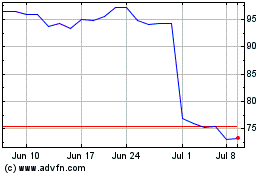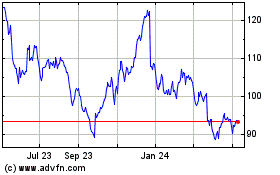By Suzanne Kapner
Unsold goods are piling up on retailers' shelves, a worrisome
trend that signals weak consumer spending heading into the Black
Friday kick off to the holiday season.
A glut could make it harder for department store chains to hit
their earnings targets in reported results arriving this week. But
it could be a boon for shoppers if higher-than-expected discounts
are needed to clear unsold merchandise.
Nomura and Citi retail analysts on Monday forecast weak
third-quarter results at Macy's Inc. and Kohl's Corp. due to
slower-than-expected sales that had left the pair awash in excess
merchandise at the end of the period. Executives at Michael Kors
Holdings Ltd. and Ralph Lauren Corp., which supply the chains with
goods, earlier said there has been a buildup of inventory at big
department stores.
Chris Peterson, president of global brands at Ralph Lauren, told
analysts last week that inventory at department stores is "a little
bit" elevated, referring to the broader retail industry.
Specialty stores and apparel manufacturers also are experiencing
"a build-up in inventories beyond the natural increase ahead of the
holidays," according to a recent report from analysts at Macquarie
Research. The report named 10 companies where inventory is growing
faster than sales, including Lululemon Athletica, Nike Inc., Under
Armour Inc. and VF Corp.
In an extreme example of the trend, Lululemon said its inventory
jumped 55% in its most recent quarter, compared with a 16% sales
increase, both over the year-earlier period. The company said it
had to restock shelves after having too little inventory a year
ago, and cited West Coast port delays that caused some goods to be
shipped later than planned.
On Tuesday, Cowen and Co. published a report warning "inventory
is above sales growth across retail," and noting that merchandise
levels were bloated at DSW Inc., Dicks Sporting Goods Inc. and
Skechers U.S.A. Inc., among other chains. Under Armour said
accelerated deliveries resulted in its higher inventory levels, but
also aided sales. VF said it stocked up since it plans to open more
retail stores. The other companies weren't available for immediate
comment. On recent calls with investors, some retail executives
cited the easing of congestion at West Coast ports, among other
reasons.
The surplus is building despite a macroeconomic backdrop that is
expected to lay the groundwork for healthy holiday spending. The
unemployment rate is falling and gas prices remain low while
consumer confidence is high. The National Retail Federation
predicts that holiday sales will rise 3.7%, only slightly less than
last year's 4.1% gain.
But as sales have sputtered, some analysts and industry
executives are beginning to question whether those predictions are
too optimistic.
"Sales over the last several months have been softer than many
retailers had anticipated," said Robert Drbul, a Nomura Securities
Co. analyst. "Consumers are not spending a lot of money on apparel
right now. They are buying electronics, cars and items for the
home."
Retailers also are feeling the effects of a downturn in tourism
to the U.S. as a result of the stronger dollar, and unusually warm
weather across much of the country that has curbed shoppers'
appetite for sweaters, coats and other cold-weather goods. Since
most retailers place orders six to nine months in advance, they
have little ability to adjust to short-term changes in demand.
The result is that inventory levels are growing faster than
sales at many chains. The gap isn't as wide as in 2013, when
retailers loaded up on goods they were unable to sell and wound up
discounting heavily to clear their shelves. Still, any buildup is
worrying to analysts, who say it sets retailers up for a difficult
start to the year-end selling season.
"If you've got excess inventory and you have to be promotional
from the outset, that means all the new goods you are bringing in
for the holidays will have to compete with the discounted
merchandise," said Paul Lejuez, a Citi analyst.
Retailers that have done a better job of matching supply and
demand are in a far stronger position. American Eagle Outfitters
Inc., for instance, has made a concerted effort over the past six
months to get lean. Its inventory in the three months ended Aug. 1
increased just 4% despite a 12% gain in sales. As a result,
American Eagle sold more items at full price during its most recent
quarter, according to Adrienne Yih Tennant, an analyst with Wolfe
Research.
Gap Inc., on the other hand, has continued to rely on deep
discounts to clear unsold goods, according to Ms. Tennant. This
past weekend, everything except leather jackets was on sale for 40%
off at its namesake brand. The company said on Monday that it had
made progress clearing out the backlog and that by the end of its
most recent quarter store inventory levels would be even lower than
its previous guidance of "down slightly."
"As expected, October was a very promotional month as we cleared
through Fall collections in anticipation of our new holiday
arrivals and in order to enter the critical season with tight
inventories," a Gap spokeswoman said.
The looming inventory glut is proving a boon for off-price
retailers like Ross Stores Inc. and TJX Cos.'s T.J. Maxx and
Marshalls chains that buy surplus goods that have either been
returned to suppliers or farmed out to jobbers and sold on the gray
market.
"They've been out there with their checkbooks picking off a lot
of very good deals," Nomura's Mr. Drbul said. That will only make
life harder for the full-priced retailers who will now be competing
with the steep bargains offered by the off-price chains.
Write to Suzanne Kapner at Suzanne.Kapner@wsj.com
(END) Dow Jones Newswires
November 10, 2015 20:01 ET (01:01 GMT)
Copyright (c) 2015 Dow Jones & Company, Inc.
Nike (NYSE:NKE)
Historical Stock Chart
From Mar 2024 to Apr 2024

Nike (NYSE:NKE)
Historical Stock Chart
From Apr 2023 to Apr 2024
